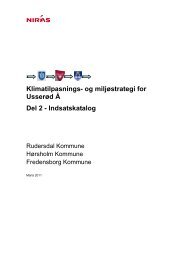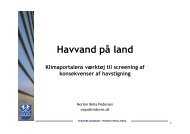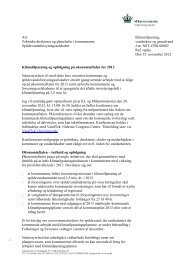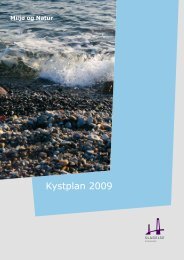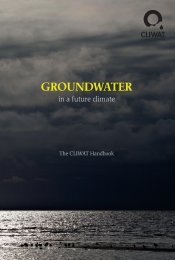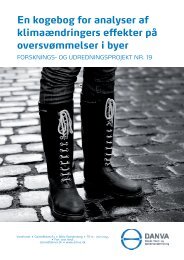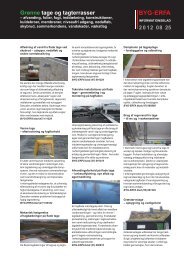Mapping climate change - barriers and opportunities for action
Mapping climate change - barriers and opportunities for action
Mapping climate change - barriers and opportunities for action
Create successful ePaper yourself
Turn your PDF publications into a flip-book with our unique Google optimized e-Paper software.
As can be seen from table 1 above, the general warming of the <strong>climate</strong> in Denmark is greatest<br />
during winter but is not fundamentally different from the warming during summer. This can be<br />
illustrated by the considerable <strong>change</strong>s in the occurrence of heatwaves. The limit value of 28ºC is<br />
only rarely exceeded in the present <strong>climate</strong>, however the predicted warming of a few degrees<br />
Celsius will increase this number drastically.<br />
For wind conditions, the <strong>change</strong>s in strong winds (storms) are expected to be more pronounced than<br />
the <strong>change</strong>s in average wind conditions. The strength, but not the occurrence, of the strongest<br />
storms over Denmark is predicted to increase during the next century.<br />
New calculations indicate a significant <strong>change</strong> in the strength of a 50-year storm in Denmark by<br />
more than 10% as early as by 2050. This result will be even more pronounced around 2100, when it<br />
will apply <strong>for</strong> the entire North Sea. Swedish calculations show a similar picture, with <strong>change</strong>s of<br />
more than 10% <strong>for</strong> a 50-year event. In these calculations, however, the <strong>change</strong>s are not statistically<br />
significant until toward the end of this century.<br />
1990 2050 2100<br />
Frosty days 85 d/y (± 8 d/y) 61 d/y (± 7 d/y) 29 d/y (± 5.3 d/y)<br />
Growing season 230 d/y (± 11 d/y) 270 d/y (± 12 d/y) 300 d/y (± 11 d/y)<br />
Hot summer nights 8 d/y (± 4 d/y) 13 d/y (± 4 d/y) 44 d/y (± 13 d/y)<br />
Precipitation events > 10mm 19 d/y (± 2 d/y) 22 d/y (± 2 d/y) 26 d/y (± 3 d/y)<br />
Precipitation events > 20mm 2 d/y (± 0.3 d/y) 3 d/y (± 0.5 d/y) 5 d/y (± 0.7 d/y)<br />
Annual highest day total 70mm (± 8mm) 75mm (± 8mm) 81mm (± 10mm)<br />
Annual highest five-day total 94mm (± 6mm) 100mm (± 5mm) 108mm (± 7mm)<br />
Mean intensity, precipitation 5.0mm/d (± 0.2mm/d) 5.2mm/d (± 0.2mm/d) 5.6mm/d (± 0.2mm/d)<br />
Heatwave days 1.5d/y (± 0.6d/y) 2.8d/y (± 1.0d/y) 5.0d/y (± 2.6d/y)<br />
Longest heatwave 3.2d (± 0.7d) 4.2d (± 0.9d) 5.6d (± 1.9d)<br />
Warm spell days 5.8d (± 1.4d) 8.7d (± 2.2d) 13.9 (± 4.7d)<br />
Longest warm spell 6.9d/y (± 1.1d/y) 8.2d/y (± 1.4d/y) 10.1d/y (± 3.3d/y)<br />
Table 3. Climate parameters <strong>for</strong> Denmark.<br />
A number of <strong>climate</strong> parameters are indicated <strong>for</strong> 1990, 2050 <strong>and</strong> 2100. The figures in the three<br />
columns represent mean values <strong>for</strong> the periods: 1961-1990, 2021-2050 <strong>and</strong> 2071-2100. All figures<br />
are from model runs with a 25km x 25km resolution grid, <strong>and</strong> the calculated extreme values will<br />
there<strong>for</strong>e generally be smaller than observed extremes, which are normally based on point<br />
measurements. The A1B scenario has been used <strong>for</strong> projections. The uncertainty indicates the<br />
ensemble-based st<strong>and</strong>ard deviation <strong>for</strong> the ensemble average value of 14 <strong>climate</strong> model runs <strong>for</strong><br />
1990 <strong>and</strong> 2050 <strong>and</strong> 8 <strong>climate</strong> model runs <strong>for</strong> 2100. Note that the figures do not take into account<br />
the fact that the 1990 values may be slightly different depending on whether they are based on the 8<br />
runs or the 14 runs. The definitions <strong>for</strong> the individual <strong>climate</strong> parameters are described in the<br />
following.<br />
19






